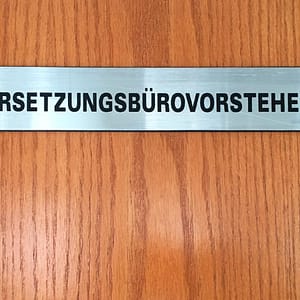Which French Variant Will Resonate with Your Audience? European vs. Canadian French
While translating into French can help any organization expand its reach, the language must be tailored to the target audience. This isn’t always easy. French is a nuanced language with distinct variants. In this article, we examine the forms of French spoken around the world to help you develop a translation strategy targeted to the people you want to reach.
French — a Global Language With a Historical Legacy
French is a global language with the power to engage people across the commercial, cultural, and diplomatic landscape. As the official language of 29 countries, French is the fifth most widely spoken language in the world and growing fast. The number of Francophones in Africa is rising rapidly. According to the Organisation internationale de la Francophonie, there will be more than 700 million French speakers by the year 2060.1 A study by investment bank Natixis even suggests that within 30 years, French could supplant both English and Mandarin to become the world’s most spoken language.2
Not only is French one of the most important languages in global business, it is renowned from a cultural perspective. (The word “culture” is actually derived from French.) It is also integral to diplomacy, used as one of the official languages of the UN, the European Union, Interpol, the African Union, the Olympic Games, the Red Cross, and Doctors Without Borders (also widely known by its French name, Médecins Sans Frontières).
A Quick History of the French Language
Originally derived from Vulgar Latin, the language that would one day become French was brought to Gaul, an area roughly equal to modern-day France, by Roman conquerors during the 2nd and 1st centuries BC. Latin took hold and eventually replaced Gaulish as the prevailing language of the region. The native Gaulish language did not disappear entirely, however. Today’s modern French is said to include about 70 words of original Gaulish origin, such as bruyère (heather), chêne (oak tree), ruche (hive), mouton (sheep), and tonneau (barrel).
In the 9th-13th centuries, Old French developed out of the Romance dialects of Northern Gaul, to become an independent language with its own grammar and vocabulary. It continued to evolve over the centuries, and with France’s wide-ranging cultural influence across Europe and colonial expansion beyond, it became an international language.
How French Influenced the Development of English
French had a dramatic impact on the English language. In 1066, William the Conqueror and his Normans brought the developing French language to England. While English was relegated to the peasants, French was adopted by the upper classes and became the official language of Britain for almost 300 years. During this time, more than 10,000 French words made their way into English, many of which are still in use today. It’s estimated that around 30% of English words originate from Old French, including words such as government (gouvernement), beef (bœuf), salad (salade), passport (passeport), and pistol (pistolet).
Given their shared vocabularies and alphabet, English and French may seem like similar languages. Both have a lot of rules, along with plenty of exceptions. However, there are some very significant differences:
- Similarly to Spanish and German, French assigns genders to nouns, and adjectives change according to the gender of the noun they modify.
- Spacing rules are different. French requires a non-breaking space before many common punctuation marks, including “!”, “?”, and “:”, where English does not. So, “Do you speak French?” in English becomes Parlez-vous français ? in French. These rules are slightly different in French-speaking Canada, but your language services provider will be able to advise you on exactly which rules apply to the audience you are targeting.
- Capitalized words are not used as frequently in the French language. For example, days of the week, months, adjectives of nationality, and the names of languages are not capitalized unless they are used at the start of a sentence.
- As with English and other languages, there are multiple registers or levels of formality in French. Niveau soutenu (elevated register) is the most formal “literary” register, while niveau argotique (slang register) is most casual.
Change in the Face of Mortal Danger
Like most languages, French continues to evolve and adapt to the needs of its users, despite very stringent language preservation efforts.
The task of guarding the French language falls to the Académie française (the French Academy). The Académie’s 40 elected members (the immortals or les immortels) publish the official dictionary and determine vocabulary, grammar, and usage rules. In recent years, the immortals have been called on to consider hot-button issues such as inclusive writing and gender neutrality. The Académie has largely rejected efforts to introduce gender inclusivity, warning that proposals to use less masculine terminology pose a “mortal danger” to the language. However, in 2019, after years of opposition, the Académie formally decreed that feminine names could be used for job titles. For example, it is now acceptable to use professeure for a woman teacher instead of the masculine professeur.
The digital age continues to introduce changes. Many new English technological terms are finding their way into the French language. Commonly-used words such as internet, blog, wi-fi, and streaming are adapted directly from English. Other terms that are easily recognizable to an English speaker include curseur (cursor), mémoire (memory), and téléphone intelligent (smartphone).
French for Canada vs. European French
In Canada, the French language took a very different path. It all began in 1534 when an expedition to find a route to China landed Jacques Cartier on the coast of modern-day Canada. As the French settled the area, their language became the lingua franca of the new northern frontier. Even after “New France” was ceded to the British in 1763, many Canadians continued speaking their first language. Because Canadian French (also known as Québec French or québécois) developed in relative isolation from its European cousin, the language evolved into a distinct variant.
Today, French is the mother tongue of about 7.4 million Canadians (21.4% of the country’s population).3 In the province of Québec, where French is the official language, 95% of residents claim it as their first or second language.
The Differences Between French for France and Canadian French
While people in Québec can understand people in France, the differences are significant, even more so than the variations between British and American English. In fact, many consider the relationship between the French variants more akin to that of European Portuguese and Brazilian Portuguese.
Canadian French has different vocabulary, idioms, slang, cultural references, and expressions that may be unfamiliar to those who speak European French. However, the largest difference is pronunciation, so much so that Canadian and European French are not always mutually intelligible. Accents and pronunciations can differ enough that a Canadian might need to modify their accent a bit to be fully understood by a European Francophone.
Here are some of the most significant differences between Canadian and European French:
- Canadian French sounds older. Because the language was isolated from European French, it has retained some of the French verbs, vocabulary, and expressions used in 17th-and 18th-century France. Some words still preserve the old-fashioned pronunciation, and the accents of today may sound antiquated to Europeans.
- Due to its proximity to the United States and English-speaking regions of Canada, the French spoken in Canada includes more Anglicisms—words taken from English with little or no alteration. Some terms are also adopted from the country’s indigenous people, such as carcajou (wolverine) and atoca (cranberry).
- Canadian French uses a less formal means of address. The informal tu (you) is far more common in Canada, while the formal vous is limited to business, or similar situations.
- It’s common in Canadian French, especially in colloquial registers, to use contractions when certain prepositions are combined with articles, such as s’a rather than the more proper sur la, or dins instead of dans les.
To ensure your translation sounds natural, it is always appropriate to use the Canadian variant when translating for a Canadian audience. Likewise, French for France is the proper choice when translating for Europe.

Fun Facts About the French Language
Download this sheet to learn about the French-speaking world, false friends, and more.
Download Now"*" indicates required fields
The Future of French Is African
French President Emmanuel Macron has described Africa as “the continent of the future.”4 The Organisation internationale de la Francophonie predicts that by 2060, 75% of the world’s 700 million French speakers will be under the age of 30 and living in Africa.5
Colonialism brought French to Africa, and while decolonization swept the continent in the ’50s and ’60s, the language is now widely embraced there. Its fast growth rate is due in part to high birth rates in French-speaking African countries, along with new language learners in English- and Portuguese-speaking nations. Across the continent, French is often spoken alongside indigenous languages and infused with local vocabulary and idioms. This means that, at least in an informal context, the language can differ significantly from one country to the next.
The Right French for Your Audiences
French is the language of the past, but also a language of the future. Translating into French presents huge opportunities, but as with any language, it’s important that the French sound natural to your target audience. Work closely with your language company, and have an upfront discussion about your audience and intent. By using linguists who are native speakers of the appropriate French variant, your language provider can deliver French translations that will sound natural in the locale you are targeting.
 Named to the 2023 Inc. 5000 list of fastest-growing companies and ranked among the world’s top 100 language service providers by CSA Research
Named to the 2023 Inc. 5000 list of fastest-growing companies and ranked among the world’s top 100 language service providers by CSA Research

